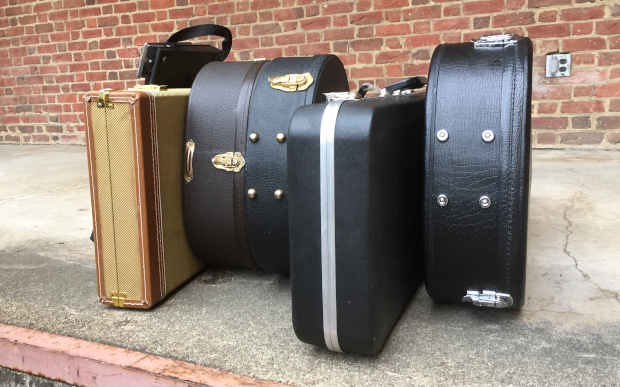Session Files: The Circus Parade
Composing Under Extreme Time Pressure

11/12/2021
Well, this session began inauspiciously. The producer had sent me scratch mixes of two songs with synthesized guitar parts and had requested that I duplicate those parts closely on the electric guitar but do so with a guitarist's touch. There was no sheet music. While loading my kit into the studio I caught my toe, tripped, and fell headlong down a set of concrete stairs by the loading dock, bashing my head up pretty well. For a few minutes I lay on my back facing the sky until I could get through the waves of pain and stand up. I limped back home and my lovely wife fussed over me and patched me up. That left me laying on the couch at home, nursing an ice pack and recuperating, for two days. My gear languished at the studio so I couldn't work on the parts. Meanwhile, the production date sprinted ever closer.
Two days later I was able to get to the studio and start working with only a day to deliver. In the interim, I had received additional iso tracks of my proposed parts. I discovered that the parts were complicated and were performed in a way that was very much idiomatic to the keyboard. In the time I had there was no way to memorize and perform the parts through. What to do? I looked to the circus for inspiration.
Have you ever seen the circus parade at the very end of a circus performance? It seems to go on and on with hundreds of performers, animals, and costumes! However, if you've ever had the opportunity to be backstage at the circus during the circus parade you get another perspective, entirely. One time many years ago, my wife and I got that chance. The circus parage is an amazing evolution, a display of rapid costume changes and adaptation. The initial group of performers goes out and marches around the arena, perhaps in Arabian costumes, riding on horses. The acrobatic motorcycle riders follow the horse riders into the arena. Backstage, the grips have wheeled out road cases and stand by to handle a massive change. As the horse riders come in the door, they hop off the horses, switch to Indian costumes proffered by the grips, mount elephants and que in at the end of the acrobatic motorcycle line. The grips frantically and lovingly stow the Arabian costumes and take the horses to the stables. Meanwhile, it turns out that the motorcycle riders were actually the clowns. When they come backstage, they strip off the black jackets revealing their clown costumes. They mount the clown cars and que up behind the elephant riders. When the first of the elephant riders come back in the door they hop off the elephants and peel off their Indian costumes, revealing that they were actually the high-wire acrobats, and they que up to march behind the clowns. And so it goes. What looks like an endless parade of performers out front is actually a small group of people frantically changing costumes and props and looping back out. The actual parade never really exists, it is simply an illusion. In fact, whatever portion you see at the moment is all that really exists.
In the case of this recording session, I had to construct the parts exactly the same way: I listened to the song, chose a small section, memorized the part and its nuances, performed it, and doubled it. Then I moved on, selecting another small bite, basically as much as I could quickly memorize, and started the process again. Each time before I moved on, I made sure the parts would dovetail seamlessly. We eventually had tracks that faithfully reproduced the spirit of my client's composition, but that sounded gutsy and "guitaristic." I never memorized the entire song or even an entire verse or chorus. I simply memorized individual gestures. Because I only used short-term memory, at the end of the session, the memorized parts had vaporized into the ether.
It is a heck of a way to perform but it gets the job done under pressure... and in a small amount of time.
= =
=

